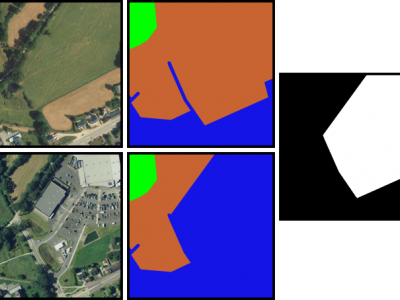Sensors

SeaIceWeather Dataset
This is the SeaIceWeather dataset, collected for training and evaluation of deep learning based de-weathering models. To the best of our knowledge, this is the first such publicly available dataset for the sea ice domain. This dataset is linked to our paper titled: Deep Learning Strategies for Analysis of Weather-Degraded Optical Sea Ice Images. The paper can be accessed at: https://doi.org/10.1109/jsen.2024.3376518
- Categories:
 373 Views
373 Views
Various modes of transportation traverse our roadways, highlighting the importance of object classification for improving traffic safety. Optical sensors that rely on visual data encounter challenges in adverse weather conditions, where poor visibility hinders target classification. In this project we use an off-the-shelf millimeter wave Frequency Modulated Continuous Wave (FMCW) radar -- Texas Instruments IWR1843BOOST module to classify on road objects. By combining the radar module, Robot Operating System (ROS), and Python scripts, we extracted a dataset of 3D point cloud images.
- Categories:
 98 Views
98 Views
The uploaded project is the code and dataset for Charging Efficiency Optimization Based on Swarm Reinforcement Learning under Dynamic Energy Consumption for WRSN. The details of each document in the uploaded project are as follows. Document data: The data file contains network data and simulation data. Document iostream: The iostream file contains the program for reading data and writing data. Document main: The main file contains the main program that executes the simulation. Document network: The network file
- Categories:
 91 Views
91 Views
Shape displays, devices which can actively alter their surface topology, have promising applications for human-robot-collaboration, haptic interaction, and manufacturing. However, these use-cases are limited due to existing challenges in dynamic object control on the shape display surface. This dataset provides experimental data supporting a general-purpose, extendable potential field algorithm that is used to control velocity and object motion on shape display surfaces. The dataset includes ball position and velocity data over time for multiple trials of experiments.
- Categories:
 8 Views
8 ViewsWe investigated the long term functionality of the designed PMCS in a practical use case where we monitored plant growth of classical horticulture Dianthus flowers (Dianthus carthusianorum) under the effect of plastic mulching over a period of 4 months. This use case represents a common phenological monitoring case that can be used in agricultural studies. For this, we integrated our PMCS in an embedded vision camera equipped with the openMV H7 Plus board in a waterproof housing [26]. The system shown in Fig.
- Categories:
 78 Views
78 ViewsIn our ever-expanding world of advanced satellite and communications systems, there's a growing challenge for passive radiometer sensors used in the Earth observation like 5G. These passive sensors are challenged by risks from radio frequency interference (RFI) caused by anthropogenic signals. To address this, we urgently need effective methods to quantify the impacts of 5G on Earth observing radiometers. Unfortunately, the lack of substantial datasets in the radio frequency (RF) domain, especially for active/passive coexistence, hinders progress.
- Categories:
 589 Views
589 ViewsAnomaly detection plays a crucial role in various domains, including but not limited to cybersecurity, space science, finance, and healthcare. However, the lack of standardized benchmark datasets hinders the comparative evaluation of anomaly detection algorithms. In this work, we address this gap by presenting a curated collection of preprocessed datasets for spacecraft anomalies sourced from multiple sources. These datasets cover a diverse range of anomalies and real-world scenarios for the spacecrafts.
- Categories:
 835 Views
835 ViewsThe dataset presents a comprehensive collection of environmental sensor measurements conducted under conditions typical of the harsh environment found in high-energy physics detectors. The dataset includes measurements of relative humidity obtained from a capacitive-based humidity sensor:
- Categories:
 184 Views
184 Views
This is the experimental data of the OFBG-BIWS for underwater applications. The efficient perception of the underwater flow field is of great significance to the development of underwater intelligent equipment. Driven by unique whisker receptors of the harbor seals, this study proposes and demonstrates a bio-inspired whisker sensor based on orthometric Fiber Bragg Grating (OFBG-BIWS). Four FBGs are deployed around an artificial whisker as basic sensing units. The hydrodynamic information is encoded as the wavelength evolution of the FBGs.
- Categories:
 13 Views
13 Views
The dataset consists of experimental data collected in an anechoic tank, with a specific setup involving single-source transmission and reception by a 6-element circular array with a radius of 0.046 meters. The transmitted signals include common wideband signals used in underwater positioning and communication, such as chirps, single-carrier QPSK, multi-tone signals, and OFDM signals. The transmitter and receiver are located at the same depth, and the receiving array rotates 360 degrees with 30-degree intervals.
- Categories:
 323 Views
323 Views


